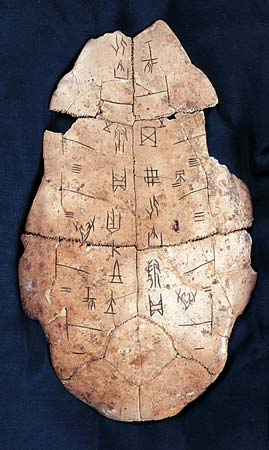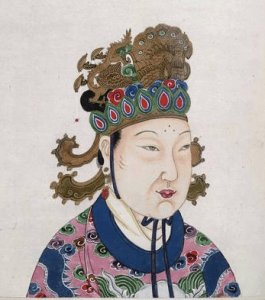We have all had our fair share of curiosity when it comes to predicting our future. We buy magic 8 balls, and go to fortune tellers. This same curiosity was present all the way back to 1600 BCE, in the Shang Dynasty of China, but at that time magic 8 balls had not been invented. Instead, the Shang created Oracle Bones to see what their futures held.
Oracle bones are pieces of ox scapula or turtle plastron, which were used for pyromancy, a method of telling the future using fire, in ancient China, mainly during the Shang dynasty. The oracle bones of this dynasty are said to have been unearthed over a period of many years by local farmers in three different Chinese dynasties, but local inhabitants did not realize what the bones were, and most times they simply reburied them. During the 1800’s, Chinese villagers were digging in the fields when they discovered a number of these bones and used them as “dragon bones,” which was a traditional Chinese medicine practice of grinding up fossils from almost twelve thousand years ago into tonics or poultices. The turtle shell fragments were prescribed for malaria, while the other animal bones were mixed and produced into a powder to treat knife wounds.1

The Diviners would ask Chinese deities questions directed towards their own ancestors, considering that their faith placed a strong respect towards for elders. Other questions asked addressed future weather, crop planting, the futures of members of the royal family, military matters, hypothetical business endeavors, and more. These questions were carved onto the bone or shell in a special form of Chinese characters known as oracle bone script, using a sharp tool. During the special session, the bone was often covered in blood along with the name of the diviner and the date for record keeping purposes. Heat was then applied with a metal rod until the bone or shell cracked due to the bone expanding because of the heat. The diviner would then interpret and analyze the pattern of cracks and write the predicted future on the piece as well, and in some cases recorded the outcome on the bone, provided the bone was still intact by the end of the divining session. By the time of the Zhou dynasty, cinnabar ink and brush had become the preferred writing method, resulting in fewer carved inscriptions and often blank oracle bones being unearthed.2

The oracle bones also bear the earliest known ancient Chinese writing and contain important significant information such as the complete royal genealogy of the Shang dynasty, or a complete royal family tree. When they were discovered and deciphered in the early twentieth century, these records confirmed the existence of the Shang, which some scholars had doubted until then. Scholars then discovered a variety of 4500 characters written on the oracle bones, but only discovered what 1700 of these characters meant. The resemblance between the oracle bone script and the modern Chinese script is an obvious one, and scholars were able to identify the meaning behind the script because of this.3
To this day oracle bones are still being discovered in many areas of the Zhōuyuán, which is the original location of the Zhou. Although many oracle bones have been found, few were inscribed. It is thought that a new writing method had been discovered and pyromancy was no longer used.
- John King Fairbank and Merle Goldman, China: A New History (Cambridge, Mass: Belknap Press of Harvard University Press, 1998), 152. ↵
- Peter Hessler, Oracle Bones : A Journey between China’s Past and Present (New York : HarperCollins, 2006), 33. ↵
- Fei Deng and Xu Wen, “On the Image Schemas of Time Expressions in the Oracle-Bone Inscriptions of Ancient China’s Shang Dynasty,” Journal of Sino-Western Communications vol 4, no. 2 (Dec 2012): 91. ↵



30 comments
Samson Pullattu
It is interesting how complex some superstitions are and gets even more interesting when one wonders how these processes came to be. Why and how was a connection made between the bones of oxen of all things to the future? What did people then do if these outcomes did not take place? Since the use of oracle bones was a long one, was this method so effective as to chalk up any failures as rare mishaps? Superstitions are fun to learn about, but it is difficult not to wonder how they could have possibly come to be?
Amelia Hew
I read that people from ancient China rely deeply on methods such as using the oracle bones to predict the future of a person or kingdom. People believed that by doing so god will be able to answer them and find solution to the problem. However, sometimes this method was misused by other as an excuse to pull competitions down in order to gain higher fame or wealth, if one was said to predicted as ‘unlucky’ and would cause death of family members, it usually results in that person being either sent away or put to death to prevent incidents from happening to the family. But it’s interesting on how people discover this method during the early ages and practice it for many years.
Victoria Salazar
Wow, this article was very fascinating. I had never heard of Oracle Bones, but I hope I get the chance to see one in person one day. Discovering the artifacts greatly helped us to learn more about their culture, beliefs, and forms of writing. I wonder if any of the events that were predicted through the Oracle Bones ever came true.
Lilliana Canales
I remember hearing about Ancient China’s oracle bones in my World History class in high school and although it was a brief topic, I found them to be something of interest. I never did research on the oracle bones, only enjoyed the fact that they existed and they were put to use for fortune telling, however this article went far more into depth than my History teacher did. For instance, I didn’t know that bones were being ground for medicinal reasons and it also wasn’t explained in class that these oracle bones were more than just fortune telling. It’s easy to dismiss the fact that these oracle bones were an example of early Chinese writing because not everyone thinks of education when thinking of ancient fortune telling.
Steven Hale
I am curious if there was actually a system for deciphering the cracks in the bone or if the diviners simply gave their own thoughts presented as an interpretation. I also wonder about the symbols the diviners used and if those symbols were standardized in any way. It is hard to imagine people learning thousands of characters without the advantages of modern record keeping and education we have now, but perhaps the ability to learn oracle bone script is what let people become diviners.
Joshua Castro
I have always been curious as to how these practices come about and how people actually start placing trust within these practices. Maybe it’s the desire that people have to be able to have their questions finally answered or just the sheer hope that something of such knowledge exists. This article did a great job at explaining how oracle bones were used as well as to why they were used.
Destiny Flores
When it comes to traditions like this, it just makes me wonder, what the first person to discover this was thinking or doing. And they continued to do it for years-that’s even more fascinating. I guess it’s the same concept of writing a letter in a bottle, sticking a cork in it, and throwing it in the ocean. Hoping it ends up somewhere and you’ll receive an answer.
Caroline Bush
Interesting article! I never knew about Oracle bones or the ways people would tell fortunes. After reading this article I found myself interested in learning more about this topic. I really liked how you put detail into this but nor to much. I was very engaged with this article and overall found it really interesting.
Ryann Cervantes
I never understood all too well how things such as these oracle bones or people and methods that would claim to tell the future were so successful and popular. Obviously we have no way of telling whether this was indeed true but if these prophets were false why would they last so long as part of the society. However, I do understand that maybe those people just liked believing in something that could possibly give them more certainty of their futures. At least these oracle bones to me are the most interesting method of predicting the future. I also liked how they were dug up and the people just didn’t think about them and buried them back in the ground.
Grace L.
Ryann,
Just a musing:
Often, in Chinese culture, people channel the wisdom of their ancestors into their daily lives. This may also be the case in the oracle bones (jia gu wen in Chinese). It is thought that the diviners felt as if the cracks were a message from their ancestors, and because the Chinese culture is so deeply rooted in the knowledge of their forefathers, they may have had deep faith in the results.
Mario Sosa
I never would have thought that the earliest form of Chinese writing came from oracle bones during the Shang dynasty. I find it to be amazing how new oracle bones are still being discovered to this day. What is really perplexing to me is how a lot of the writing has yet to be interpreted, despite its similarities to modern Chinese writing. Intriguing article, good job!